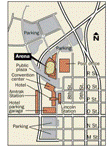Community and Regional Planning Program
Date of this Version
2017
Citation
Remote Sens. 2017, 9, 270
Abstract
Urban lakes play an important role in urban development and environmental protection for the Wuhan urban agglomeration. Under the impacts of urbanization and climate change, understanding urban lake-water extent dynamics is significant. However, few studies on the lake-water extent changes for the Wuhan urban agglomeration exist. This research employed 1375 seasonally continuous Landsat TM/ETM+/OLI data scenes to evaluate the lake-water extent changes from 1987 to 2015. The random forest model was used to extract water bodies based on eleven feature variables, including six remote-sensing spectral bands and five spectral indices. An accuracy assessment yielded a mean classification accuracy of 93.11%, with a standard deviation of 2.26%. The calculated results revealed the following: (1) The average maximum lake-water area of the Wuhan urban agglomeration was 2262.17 km2 from 1987 to 2002, and it decreased to 2020.78 km2 from 2005 to 2015, with a loss of 241.39 km2 (10.67%). (2) The lake-water areas of loss of Wuhan, Huanggang, Xianning, and Xiaogan cities, were 114.83 km2, 44.40 km2, 45.39 km2, and 31.18 km2, respectively, with percentages of loss of 14.30%, 11.83%, 13.16%, and 23.05%, respectively. (3) The lake-water areas in the Wuhan urban agglomeration were 226.29 km2, 322.71 km2, 460.35 km2, 400.79 km2, 535.51 km2, and 635.42 km2 under water inundation frequencies of 5%–10%, 10%–20%, 20%–40%, 40%–60%, 60%–80%, and 80%–100%, respectively. The Wuhan urban agglomeration was approved as the pilot area for national comprehensive reform, for promoting resource-saving and environmentally friendly developments. This study could be used as guidance for lake protection and water resource management.


Comments
Copyright 2017 by the authors.
Open access
doi:10.3390/rs9030270